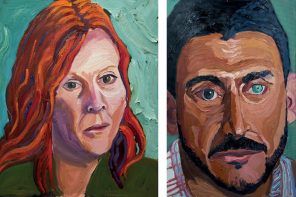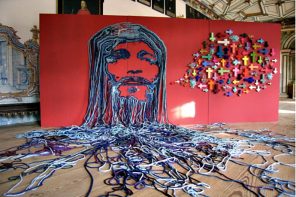Chicago saw the usual droves of sightseers this summer, filling restaurants, concerts, and museums—and thronging to gaze at public art.
Anish Kapoor’s Cloud Gate, the reflective bean-shaped orb in the art-filled Millennium Park, is perhaps the most popular piece on view, but Chicago also boasts pieces by Jean Dubuffet, Marc Chagall, Alexander Calder, and Joan Miró. Most recently, Seward Johnson’s enormous (and widely maligned) sculpture of Marilyn Monroe in her famous Seven Year Itch pose has taken up temporary residence in Pioneer Court, the flare of her windblown skirt providing shade to spectators.
But it is the untitled Picasso sculpture in Daley Plaza that remains Chicago’s most iconic artwork—a sculpture that owes some of its mystery to the mythical resonance hidden in its form.
If it Quacks Like a Sphinx
The “Chicago Picasso” has long been a source of bewildered fascination; all around it, brows furrow even as cameras click and children mount the incline of its steel base. Dedicated in 1967 as a “gift to the people of Chicago” (Picasso refused payment), the ambiguous, 50-foot-tall, 162-ton sculpture met with a combination of public affection and outrage upon its unveiling. Mayor Richard J. Daley offered these words on the occasion: “We dedicate this celebrated work this morning with the belief that what is strange to us today will be familiar tomorrow.”
Tomorrow has come, and the Chicago Picasso is indeed familiar—but no less strange than it was forty-four years ago.
What does this mysterious sculpture depict? Popular answers include: an aardvark, a bird, an Afghan hound, and one of Picasso’s lovers. But to my eyes, it looks like a sphinx—a monster that (like the anamorphic skull haunting Hans Holbein’s famous painting The Ambassadors) only snaps into focus when viewed from an oblique perspective. To perceive the recumbent sphinx you have to approach the piece not from the front, but from behind and to the side.
Sphinxes are a cross-cultural, and cross-religious, phenomenon; variants can be found guarding temples and warding off evil in India, Myanmar, and beyond. But perhaps the most widely-recognized iterations of the mythological beast are the Egyptian and the Greek sphinxes. The Egyptian sphinx typically has a man’s head and a feline body, and serves the benevolent purpose of protection. (It is worth noting that Hegel described the Egyptian religion of which the sphinx was a part as a religion of the riddle or enigma.)
On the other hand, the nefarious Greek sphinx, like the one that tormented Oedipus, sports a woman’s head and bust, a lion’s frame, and the wings of a bird; it poses a riddle to all who pass, cursing unto death those who cannot solve it.
Sphinxes also populate European art from the Renaissance on. Gustave Moreau’s 1864 painting Oedipus and the Sphinx is a classic of symbolist art, depicting the Theban king assailed by a feminine monster at once seductive and deadly. The surrealists, including Picasso, were known for engaging mythic imagery, and were particularly intrigued by composite beasts such as the sphinx. Argentine painter Leonor Fini created numerous variations on the Greek sphinx, while Salvador Dalí concocted a veritable menagerie of Egyptian and Greek sphinxes, including one scarlet-furred feline creature bearing the face of Shirley Temple and surrounded by the well-cleaned bones of her victims.
Whether in religious myth or art, and whether apotropaic or menacing, the sphinx is a sacred monster—“something extraordinary that disrupts the natural order of things,” as historian of surrealism Celia Rabinovitch has put it. Further emphasizing the sacred status of the beast, Rabinovitch notes that the “union of the [human] and the animal” in the sphinx “provokes a sense of the irrational and the holy.”
The Chicago Picasso certainly disrupts the architectural order of its surrounds, and confounds attempts at definitive interpretation. Multiply ambiguous, it is a strange concoction of any number of animal and human forms, as well as a sphinx; itself a hybrid monster. Moreover, the Chicago Picasso intimates both the Egyptian and Greek sphinxes—an amalgam of cultural styles. An ambiguous, almost inscrutable object, it is an enigmatic icon and the icon of an enigma; its very presence confronts the populace with a riddle.
The riddle is not simply what the Chicago Picasso might depict—dog, aardvark, woman, or whatever. The riddle of this sphinx is more mysterious. It is the riddle of the limitlessness of interpretation itself. Philosopher of religion Jean-Luc Marion describes great works of art, particularly religious icons, as “saturated phenomena.” In their “overwhelming givenness,” they exceed our intentional intuitions; they endlessly call for, but are never exhausted by, interpretation. Chicago cabby George Downs expressed something similar at the 1967 unveiling of the Picasso sculpture: “The longer you look, the more you see. That’s what art should be.” Art has the power of inexhaustible revelation, raising questions endlessly, and compelling intellect, imagination, and emotion to exceed their usual boundaries through the very act of interpretation.
In his extraordinary meditation on truth and interpretation, Beyond Good and Evil, Friedrich Nietzsche asks, “Who is the Sphinx? It is a rendezvous, it seems, of questions and question marks.” The sphinx hidden in plain sight within the Chicago Picasso is just that: a rendezvous of questions and question marks. In its irresolvable ambiguity, in its irrational monstrosity, the Chicago Picasso is an icon of the mystery of interpretation, a visual utterance of the sacred riddle of art itself.




